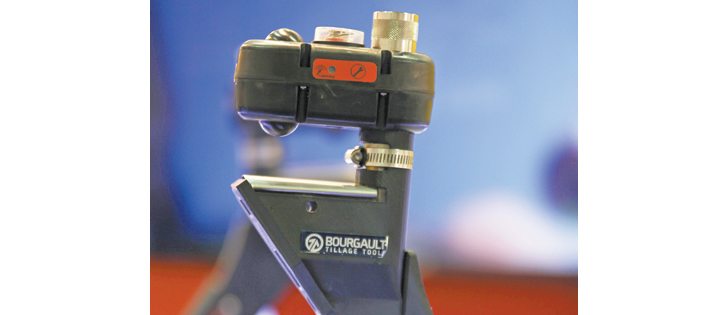HANNOVER, Germany — Bill Baker believes in the internet of things and independence of devices, even when it comes to agriculture.
His company, Agtron Enterprises, drew a lot attention at Germany’s Agritechnica farm show.
Air delivery of seed and other inputs is old hat for the Prairies and Plains, but for large parts of the world distribution by fan pressure is still a newer concept.
However, whether a producer has been depending on air to get material from meter to seed bed for decades or days, knowing the products are arriving, and in the right amounts, remains a hot issue.
Read Also

Farming Smarter receives financial boost from Alberta government for potato research
Farming Smarter near Lethbridge got a boost to its research equipment, thanks to the Alberta government’s increase in funding for research associations.
The Saskatoon business debuted its latest product, the Lightning seed rate and blockage monitor, for the 450,000 strong, Germany crowd. It’s an ironic name for a tool that is so power efficient that it doesn’t need a electrical feed to do its electronic job.
Blockage monitoring for air seeders has tended to take place up at the distribution towers. Blockages often happen 10 feet later in the flow at the seed boot, so it takes relatively long periods of time, especially for small seeded crops, for the problem to be discovered. Lost yield and neighbour-noticeable gaps are the result.
Some systems are smart enough to notice reduced flow rates due to a lower-tube blockage, but often the alarm sounds when a tube is well on its way to full.
Wires or sonic tubes don’t like long runs down the shanks or disc arms because they are constantly moving. It was this movement that Baker decided to exploit.
“There is energy there. The seed tools are constantly moving. It turns out there is enough energy to power the flow sensors,” he said at the show.
“We put our sensors down at the seed boot. It harvests energy at the shanks. You have a 400 horsepower tractor pulling that seeder or planter through the field and the biggest draw on it is the soil where it meets the machine. We just take at little of that energy as it is dissipated through movement.”
The individual sensors are powered by small, magnetic generators located in each run sensor’s case, just behind the seed boot.
A mesh network, with multiple redundancies, allows each sensor to piggyback data onto the ones next to it. Even if one were to be damaged, the rest pick up the data. Eventually all the data from all the sensors works it way back to central receiver on the drill and it is funneled wirelessly by standard wi-fi off to the tractor’s cab and an iPad acting as the display terminal.
“It’s the internet of things and it’s coming to the farm,” he said.
The seed tube is “nearly indestructible stainless steel” and the sensors are infrared, so dust and other distractions won’t affect the units, said Baker.
In the tractor cab, producers can be alerted on every tube run on even the largest machines and get both blockages and rates of delivery.
The Lightning units should reach the market for this season.
For more information, contact Agtron at www.agrtron.com or 306-934-0640.


















